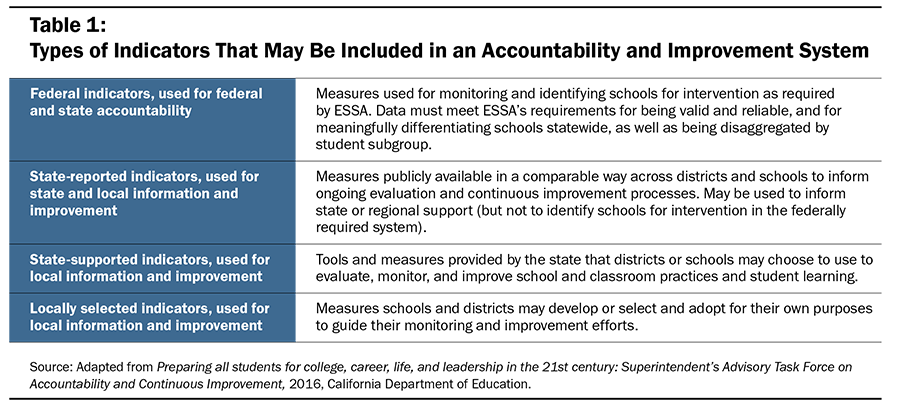Encouraging Social and Emotional Learning In the Context of New Accountability

Summary
This brief is based on the report Encouraging Social and Emotional Learning in the Context of New Accountability, which describes how states might measure and promote social and emotional learning (SEL) in their accountability and continuous improvement plans. Under the Every Student Succeeds Act, states have an opportunity to broaden their definitions of student success to include students’ SEL—the foundation for academic and life success.
The authors review measures of students’ social-emotional competencies, as well as indicators of school climate, supports for SEL, and related student outcomes. They conclude their analysis with considerations for states as they revamp their accountability systems.
Resources included in the full report include:
- Detailed description of each indicator
- Discussion of the pros and cons of using indicators for high-stakes accountability purposes
- Curated lists of and links to survey tools
- Sample survey items
The Every Student Succeeds Act (ESSA) requires state accountability systems to include indicators of “school quality and student success” in addition to indicators of academic outcomes. The new law provides an important opportunity for states to broaden the definition of student success to include measures of students’ social-emotional, as well as academic, development.
Importance of Social and Emotional Learning
Social and emotional learning (SEL) is a broad and multifaceted concept, which the Collaborative for Academic, Social, and Emotional Learning defines as
the process through which children and adults acquire and effectively apply the knowledge, attitudes, and skills necessary to understand and manage emotions, set and achieve positive goals, feel and show empathy for others, establish and maintain positive relationships, and make responsible decisions.Center for Academic, Social, and Emotional Learning. “What is SEL?” (accessed 3/27/17).
Well-implemented programs designed to foster SEL are associated with positive outcomes, ranging from better test scores and higher graduation rates to improved social behavior.Osher, D., et al. (2016). Advancing the science and practice of social and emotional learning: Looking back and moving forward. Review of Research in Education, 40(1), 644–681; Durlak, J. A., Weissberg, R. P., Dymnicki, A. B., Taylor, R. D., & Schellinger, K. B. (2011). The impact of enhancing students’ social and emotional learning: A meta-analysis of school-based universal interventions. Child Development, 82(1), 405–432. Social-emotional competencies include skills, such as the ability to collaborate or make responsible decisions; mindsets, such as thinking positively about how to handle challenges; and habits, such as coming to class prepared.
School Climate: The Foundation for Social, Emotional, and Academic Development
A positive classroom and school environment, often referred to as school climate, is the foundation for students’ social and emotional development in school. School climate covers aspects of school functioning that include safety; student and staff relationships; and support for social, emotional, and academic learning. When classrooms are safe and engaging, and learning is both supported and rewarding, students feel connected and effective—which in turn allows them to develop the social, emotional, and academic competencies they need to succeed in life.Eccles, J.S., et al. (1993). Development during adolescence: The impact of stage-environment fit on young adolescents’ experiences in schools and in families. American Psychologist, February, 90–101.
Staff can promote SEL in the classroom through practices such as supporting risk-taking and problem solving, developing an environment conducive to collaboration, and providing students with tools to recognize and talk about their feelings. It is much more difficult for students to develop the social-emotional competencies they need to build strong relationships or work through tough problems in a chaotic or punitive classroom.
Choosing Indicators and Their Place in an Accountability System
How might states encourage schools to help students develop socially and emotionally, and to foster positive school environments, in the context of new accountability? The report on which this brief is based describes how schools can use measures of students’ social-emotional competencies, school climate, and related outcomes, such as suspension rates and chronic absenteeism, to inform their practice. It then illustrates where these measures might best fit in an accountability and continuous improvement system.
We conceptualize a system for accountability and continuous improvement as multitiered, designed to provide useful information about school status and progress at the state, district, and school levels. In addition to indicators required by ESSA for identifying schools for intervention, this broader system of accountability can also include state or local indicators that offer diagnostic information to guide teaching and program investments (see Table 1).

Measuring SEL and School Climate in an Accountability and Continuous Improvement System
The authors reviewed three kinds of measures:
- Measures of students’ social-emotional skills, habits, and mindsets, which may be assessed through student self-reports on surveys, teacher observations, or performance assessments.
- Measures of school climate and supports for SEL, which measure the degree to which schools have developed structures, relationships, and learning opportunities that support students’ social-emotional development. These may be derived from student, teacher, and parent surveys, as well as observations of classroom, school, or district practices.
- Measures of related student outcomes—including chronic absenteeism and suspension rates—that are partially a result of school climate and supports for SEL.
To determine where each kind of indicator belongs in an accountability and continuous improvement system, the authors consider the following questions:
- What does the indicator measure, and how likely is it that data are actionable and can lead to meaningful improvement?
- For what use was the measure designed, and how might data be distorted if attached to high-stakes consequences?
- Does the measure generate consistent, reliable data?
- Does the measure meaningfully differentiate between schools and subgroups?
Some measures could fit in multiple tiers, depending on a state’s context. Table 2 gives an overview of these measures and where each might fit in a multitiered accountability system, depending on state values, data, and readiness.

The full report provides details about the kinds of measures that can be used to support a focus on SEL—for use in a state accountability system, which reveals how different groups of students may be experiencing school and how they are being supported; and for use at the school or district level, to help educators improve classroom and school practices. The formative use of SEL measures is particularly important for building schools’ capacity to develop and refine new practices.
Conclusion: Next Steps for ESSA State Plans
After reviewing each type of measure in greater depth, the authors make the following suggestions:
- States should not use measures of students’ social-emotional competencies for high-stakes accountability purposes, at least for now. They can, however, support the use of these measures at the local level to inform teaching, learning, and program investments. These indicators can provide important information that identifies students’ strengths and needs as they relate to SEL, which might be reported on an aggregate basis to inform school decisions about programs and supportive strategies. However, most measures of social-emotional competencies are relatively new, were not designed for cross-school comparison, and may be particularly vulnerable to reference bias because students are not always the best judges of their own level of competence. The authors therefore conclude that these measures are not currently appropriate for accountability systems at the state or federal levels, although they might be used locally.
- States could consider including measures of school climate, supports for SEL, and related outcomes in their federal accountability and statewide reporting systems. These measures may be more appropriate for high-stakes accountability systems than measures of students’ individual social and emotional competencies because school climate and supports for SEL are areas that school staff can directly influence and measurement tools tend to be more advanced.
States might consider using student surveys to evaluate school conditions and supports. They can track suspension rates and chronic absenteeism to evaluate the outcomes of these conditions. These indicators are eligible to be used as measures of "school quality and student success" under ESSA, providing a more comprehensive picture of school functioning. If used for statewide reporting, school climate surveys should be well validated and meet criteria for comparative use.
States may also opt to report these indicators without using them to identify schools for intervention under the federal law. Teacher and parent surveys might also be considered as state-reported indicators, since they provide important insight into school functioning despite not meeting ESSA’s requirements for federal accountability. - Even if not incorporated in statewide accountability or reporting systems, states can provide districts with well-validated tools for measuring SEL and school climate. Well-designed and well-implemented measurement tools can help educators make strategic decisions about needed investments in student services, programs, and professional development. These can range from measures of school climate and students’ social-emotional competencies to diagnostic measures, such as protocols for observing and reflecting on educator practices and school structures.
- State agencies and districts should provide schools with resources and technical assistance as they seek to advance SEL. Data alone will not drive school success. Staff need to be trained to analyze and act on the data they collect and to implement high-quality programs, professional development, and school organizational changes that support students’ development. State-level support may include technical assistance for program development or the facilitation of peer learning networks, as well as providing state and federal funding to support schools’ efforts.
Until recently, social and emotional learning has often been placed on the sidelines, seen as a distraction from academics. Research suggests, however, that SEL and a positive school climate are the foundation for students’ academic and success later in life. States should encourage schools to support SEL in the context of new opportunities for accountability and continuous improvement under ESSA.
Encouraging Social and Emotional Learning In the Context of New Accountability (brief) by Hanna Melnick, Channa Cook-Harvey, and Linda Darling-Hammond is licensed under a Creative Commons Attribution-NonCommercial 4.0 International License.
This research was supported by a grant from the Raikes Foundation. In addition, the S. D. Bechtel, Jr. Foundation, Ford Foundation, Hewlett Foundation, and Sandler Foundation have provided operating support for the Learning Policy Institute’s work in this area.
